Kanban: Definition, 6 Rules, and its Benefits
Kanban is a crucial part of the Just in Time (JIT) system, which we discussed…
Sean Thobias
May 17, 2025Are you curious about the differences between business-to-business (B2B) and business-to-consumer (B2C) companies? Did you know these two models have distinct differences that can impact everything from sales strategies to customer support?
For instance, while B2B companies typically focus on building long-term relationships with other businesses and organizations, B2C companies often emphasize the importance of reaching individual consumers through mass marketing.
Suppose you’re someone interested in entering the tech industry. In that case, it’s essential to understand these differences and how they can impact your career.
This article will deeply dive into the five differences between B2B and B2C companies, including their business models, market approach, customer needs, sales process, and customer support. We’ll provide concrete examples to help illustrate how these differences manifest in practice, and we’ll also provide the required skills needed to work in these companies.
By the end of this article, you will better understand the unique challenges and opportunities presented by B2B and B2C companies, which will equip you to make more informed decisions about your career path in the technology industry.
Before further detailing the differences between B2B and B2C, we must understand each definition.
Business-to-business (B2B) is a type of commerce where one business sells products or services to another business or organization. In other words, B2B transactions happen between companies, governments, or institutions.
B2B transactions usually involve more giant quantities of goods or services. The sales process can take longer and be more complex than other types of transactions.
Factors such as the company’s nature, target customers, and industry influence the business model of a B2B company. Some common business models that B2B companies include:
Intermediary-centric: This model involves a business selling its product to another company and charging an additional fee as a middleman. This strategy generates revenue to sustain operations in the long run. While the model may not be immediately profitable due to high costs, it can establish brand value by offering exclusive and valuable services to customers.
Since B2C companies sell their products or services directly to individual consumers, their business model differs from that of B2B companies. Here are some common business model types used by B2C companies:
B2B and B2C companies have different ways of doing business. B2B companies work to build long-term relationships with other businesses and prioritize offering solutions that are customized to meet their specific needs.
B2B companies focus on logic-based buying habits, emphasizing needs rather than an emotional attachment to a product.
On the other hand, B2C tech companies aim to reach a larger audience of individual consumers with a more general approach. These companies focus on branding and emotional appeal by crafting messaging that resonates with their target audience’s values and aspirations.
B2B and B2C companies have different strategies. B2B companies prioritize understanding their industry’s target audience’s needs and behavior.
One popular B2B marketing strategy is account-based marketing (ABM). It targets high-value accounts with personalized campaigns that address their specific needs. B2B marketers also create informative content such as white papers, case studies, and webinars to establish themselves as industry leaders.
On the other hand, B2C marketing targets large-scale marketing efforts that aim to capture the emotions and preferences of individual consumers. This marketing strategy involves creating ads, social media campaigns, and promotions that grab the consumers’ attention.
B2C marketing emphasizes product features and benefits, price points, and creating an emotional connection with the brand. Tactics used in B2C marketing include influencer, social media, and email marketing.
The main goal of a B2C marketing strategy is to build brand identity and a loyal customer base that leads to revenue growth through repeat purchases and positive word-of-mouth.
B2B and B2C are different ball games when selling products or services. B2B sales involve a more complex process, which can take a long time and involve multiple decision-makers.
B2B deals often involve large contracts with long-term commitments, and multiple stakeholders must justify the buying decision. A single sale can require a significant investment of time, effort, and resources from the buyer and the seller.
To make a successful sale in B2B, you may need to go through several stages, such as prospecting, lead qualification, proposal creation, negotiation, closing the deal, and a follow-up. Building a solid relationship with clients is crucial throughout this process since B2B transactions often rely on trust, mutual respect, and collaboration.
In contrast, B2C sales are much simpler, and the sales cycle is shorter. These deals usually involve fewer decision-makers since the customer navigates the buying process independently. Customers may receive influence from social media, affiliates, or ads before engaging with B2C sales. They may also actively seek advice from friends, family, or product reviews, particularly for expensive purchases.
When businesses sell products or services to other companies (B2B), they usually provide customer support, which helps the customers with technical problems, general questions, and other issues.
B2B companies generally provide more comprehensive customer support than B2C companies — because B2B customers are fewer and often have more complex needs.
B2B businesses offer customer support that can involve assisting customers with integrating their products and services with other systems, providing training, and managing customer accounts. These tasks can be challenging, so B2B companies typically have a specialized support team to handle them.
On the other hand, B2C customer support focuses on helping individual customers. Individual customers are usually more self-sufficient and want quick and efficient solutions to their problems.
B2C companies can provide efficient self-service options, such as automated chatbots, to help customers quickly get the necessary information. They should also have an easy-to-use website with helpful resources, such as detailed product information, to assist customers in finding what they need.
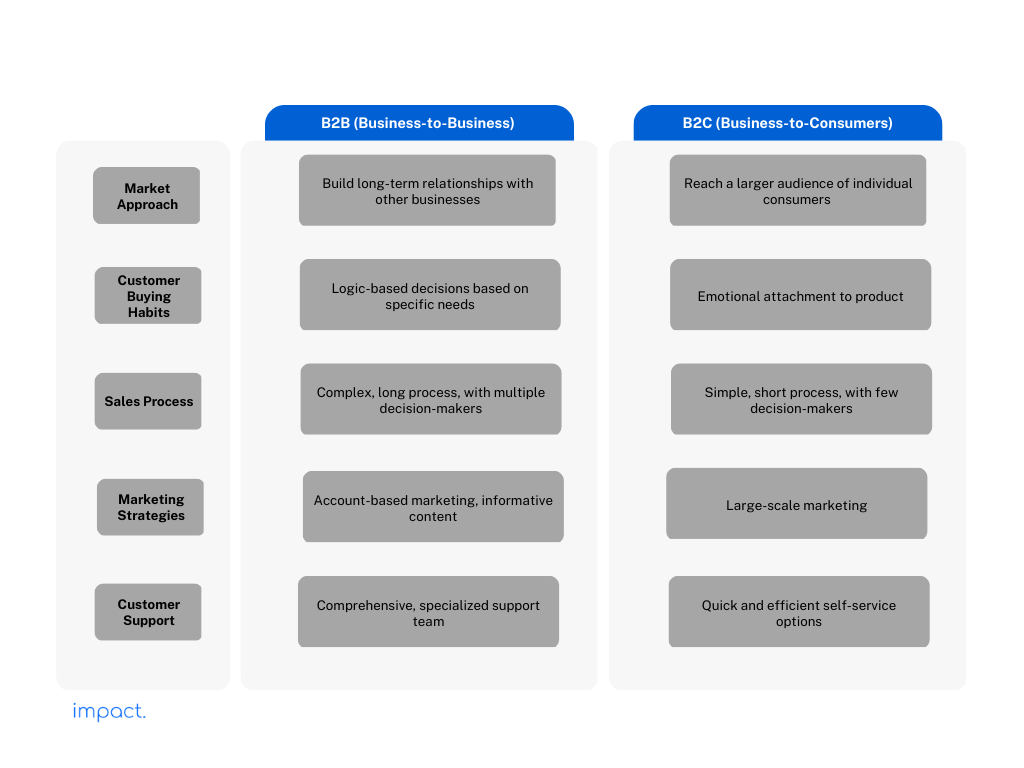
In the tech industry, companies sell products or services to either other businesses (B2B) or individual customers (B2C).
B2B tech companies focus on serving other businesses by providing tools and services to help with their day-to-day operations. Let us share two examples of B2B tech companies to give you a better idea.
B2B tech companies focus on serving other businesses by providing tools and services to help with their day-to-day operations. Let us share two examples of B2B tech companies to give you a better idea.
Microsoft is a tech company that operates primarily as a B2B, selling software, hardware, and services to other businesses and organizations.
Some examples of Microsoft’s B2B products are Office Suite, which includes popular applications like Word, Excel, and PowerPoint. The company also sells Azure, a cloud-based platform that helps businesses manage their data and applications on Microsoft’s servers.
In addition to software, Microsoft also designs hardware products like Surface laptops and tablets that cater to business needs. The company also offers various services to businesses, from technical support to consulting and training.
Adobe is a company that makes software for creative professionals and marketers. They have products like Photoshop and Illustrator for creatives, Adobe Campaign, and Adobe Experience Manager for marketers.
Adobe is different from regular companies that sell to individual consumers. They make products for people who work in businesses, like creatives and marketers. They sell licenses and subscriptions to these businesses rather than to individual consumers.
Now, let us share two examples of B2C companies that operate in the tech industry.
Apple primarily operates as a B2C company, designing products such as the iPhone, iPad, and Mac for individual consumers. They sell their products directly to consumers through retail stores, websites, and third-party retailers, with customer service tailored to the needs of individual consumers.
Apple’s marketing campaigns are known for their emotional appeal, emphasizing the brand’s image and highlighting features that resonate with consumers, such as taking photos or playing games.
While Apple does offer some products and services for businesses, they are not a significant part of its overall business strategy.
Netflix is a company that provides a streaming service for movies, TV shows, and original content directly to customers through subscription-based plans.
They build their business model around delivering high-quality content and ensuring a user-friendly customer experience. Netflix uses personalized recommendations, invests in original content production, and prioritizes user interface design to make the service more enjoyable.
This approach has helped Netflix to build a large and loyal customer base, making it one of the most successful streaming services in the world.
Working in a B2B (business-to-business) company requires unique skills and knowledge. Here are five skills you need to develop to excel in this field:
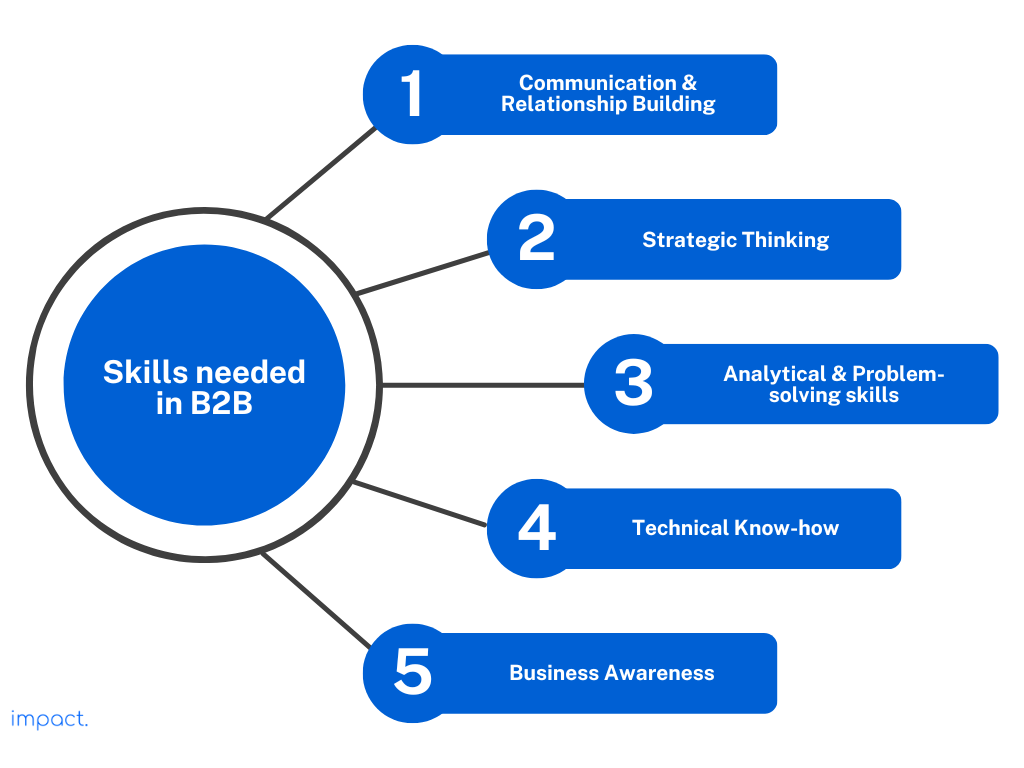
To work in a B2B company, you must frequently communicate and engage with other businesses, vendors, and clients. It’s essential to have strong communication skills to express your ideas clearly and negotiate deals effectively.
Moreover, you’ll have to maintain relationships with other businesses, which involves listening actively to their needs and showing empathy toward their concerns.
In B2B companies, having a strategic mindset is crucial. You must think ahead and make decisions supporting the company’s long-term goals.
A deep understanding of the market, customer needs, and the competitive landscape are essential to achieve a strategic mindset. This understanding will help you stay ahead and make informed decisions.
In a B2B company, you must have strong analytical skills to analyze data such as sales, customer feedback, and market trends to make informed decisions.
Moreover, you should be able to identify problems and provide innovative solutions that meet your client’s needs. This requires critical thinking, strong problem-solving skills, and thinking outside the box.
Technical skills are essential for success in many B2B industries, like technology, manufacturing, and engineering. Depending on your role, you may need product development, system integration, software development, data analysis, or project management skills.
Being proficient in technical skills can give you an edge and help you perform your job effectively. It can also help you understand client needs better and provide them with better solutions.
Understanding the business processes is vital for success in a B2B company. This means understanding the B2B landscape, your company’s industry, and the customer’s business.
Business awareness also involves knowing the financials to negotiate effectively. With this understanding, you can identify potential clients, offer practical solutions, and build strong relationships.
Now, if you want to work in a B2C (business-to-consumer) company, the required skills may differ from working in B2C. Here are some skills that can help you succeed in this field.
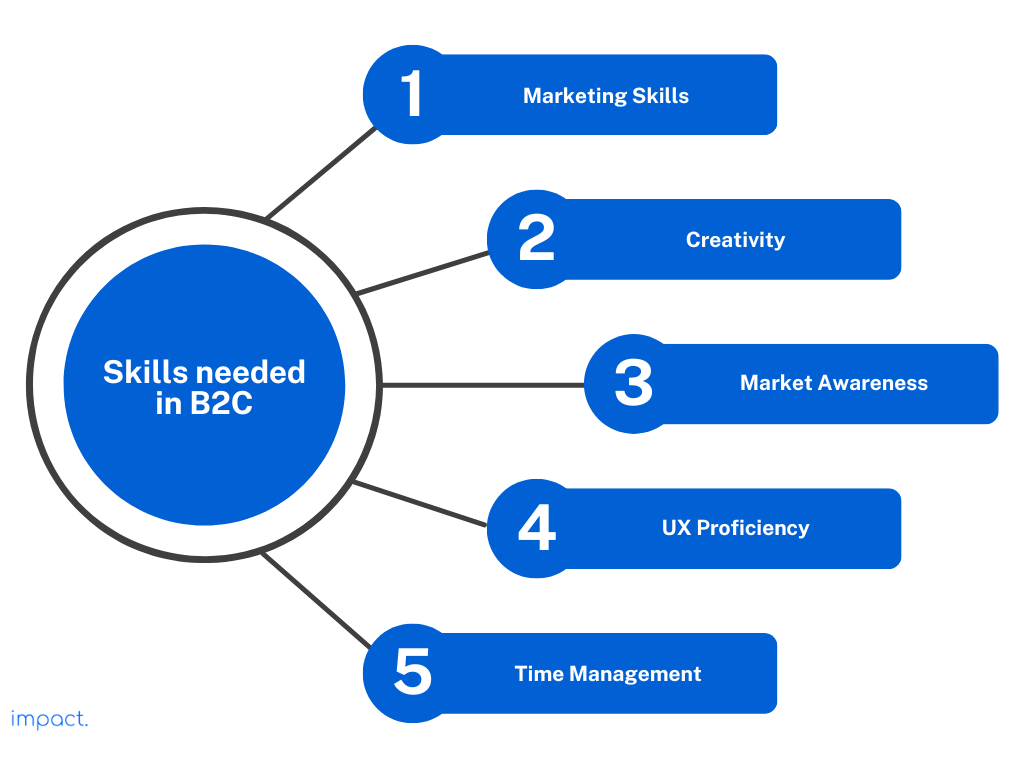
Marketing is crucial for B2C companies to attract and retain customers, understand their needs, build brand awareness, and drive sales.
Being familiar with marketing concepts and strategies such as social media, email, and content marketing is crucial to excelling in working for B2C companies. These marketing efforts aim to capture the attention of individual consumers through large-scale marketing efforts such as ads, social media campaigns, and promotions.
B2C companies often rely on creating innovative and engaging marketing campaigns to capture the attention of individual consumers and differentiate themselves from competitors.
Creativity allows you to develop unique ideas, designs, and messages that resonate with customers and build brand loyalty.
Additionally, it enables you to think outside the box and develop creative solutions to problems that may arise in the workplace.
Marketing awareness is crucial when working for a B2C company. Understanding the target market, their needs, preferences, and behaviors, and how to communicate effectively, is essential for success.
By knowing marketing fundamentals, such as research, advertising, promotions, and branding, you can help the company achieve its goals. This awareness also keeps you up-to-date with the latest trends and technologies, making you a valuable asset to the company.
UX refers to a user’s overall experience when interacting with a product or service, including its design, usability, and functionality.
A positive user experience is crucial in B2C companies for attracting and retaining customers. Understanding UX principles such as user research, information architecture, and usability testing helps design products that meet the target market’s needs and preferences.
Knowing UX helps you identify and solve problems that users face when interacting with the company’s digital products, leading to improved customer experience, satisfaction, and loyalty – ultimately driving sales and revenue.
B2C businesses have a shorter and simpler sales cycle, and customers expect immediate satisfaction. These companies depend on quick turnarounds for marketing campaigns, promotions, and product launches to stay competitive in the fast-paced market.
In a dynamic environment, practical time management skills are essential to succeed. This involves prioritizing tasks, delegating responsibilities, and meeting deadlines. Effective time management can ensure projects are completed on time and within budget, contributing to the company’s success.
Educating yourself about the differences between B2B and B2C is crucial if you’re looking to start a career in the tech industry.
So if you’re still unsure about which direction to take, we encourage you to dive deeper into the five critical differences discussed in this article. Take time to reflect on your career goals, strengths, and interests, and then use this information to make an informed decision about your future.
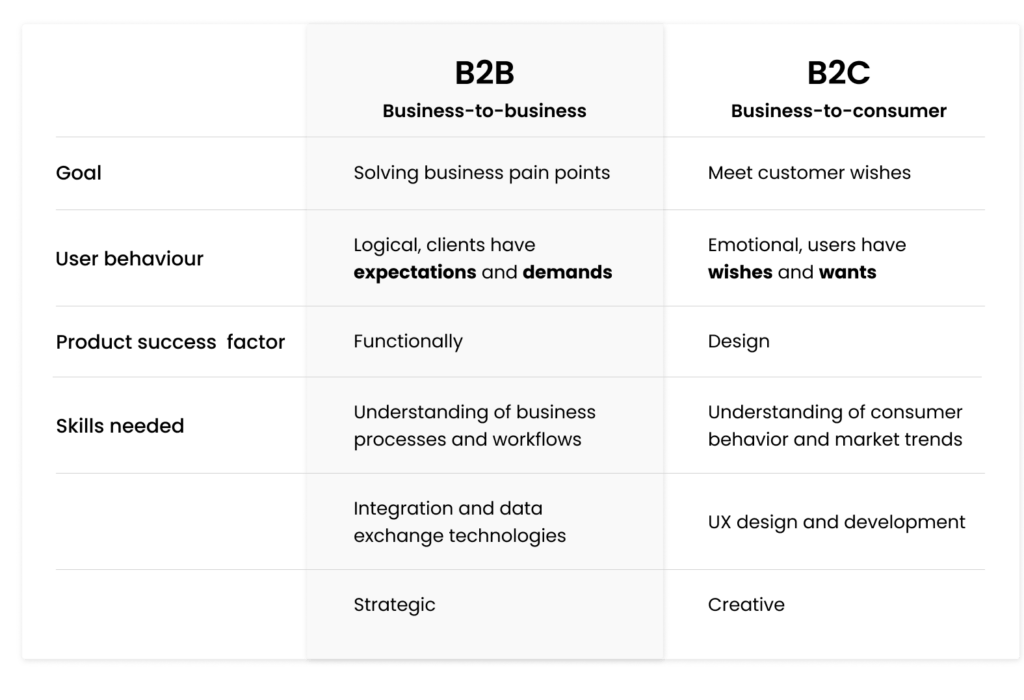
With this knowledge, you can confidently take your first steps toward a successful and rewarding career in the tech industry.
Impact Insight Team
Impact Insights Team is a group of professionals comprising individuals with expertise and experience in various aspects of business. Together, we are committed to providing in-depth insights and valuable understanding on a variety of business-related topics & industry trends to help companies achieve their goals.
See how our software provides better value.
Speak with our consultant to explore how we can improve your accounting, processes, and people.

A distributor is someone or a company that helps to sell and deliver goods and services from the producers to the customers. They are necessary for many industries, such as electronics and pharmaceuticals, as they link the manufacturers and customers.
As technology advances, customers want goods delivered quickly, and distributors become more critical in the supply chain.
This article provides a complete understanding of distributors, including their types, functions, and benefits. It also outlines what businesses need to consider when selecting a distributor so that they can make informed choices about their distribution channels.
A distributor is a middleman that helps transfer products or services from manufacturers or suppliers to retailers and end-users.
Distributors typically work with many manufacturers and downstream entities and act as an agent for each manufacturer, agreeing to sell their products to retailers, value-added resellers (VAR), or wholesalers.
People sometimes mix up distributors and wholesalers, but they are pretty different.
Wholesalers mainly purchase goods in bulk from manufacturers and sell them to retailers. On the other hand, distributors have a more extensive range of responsibilities, including marketing, warehousing, and financing.
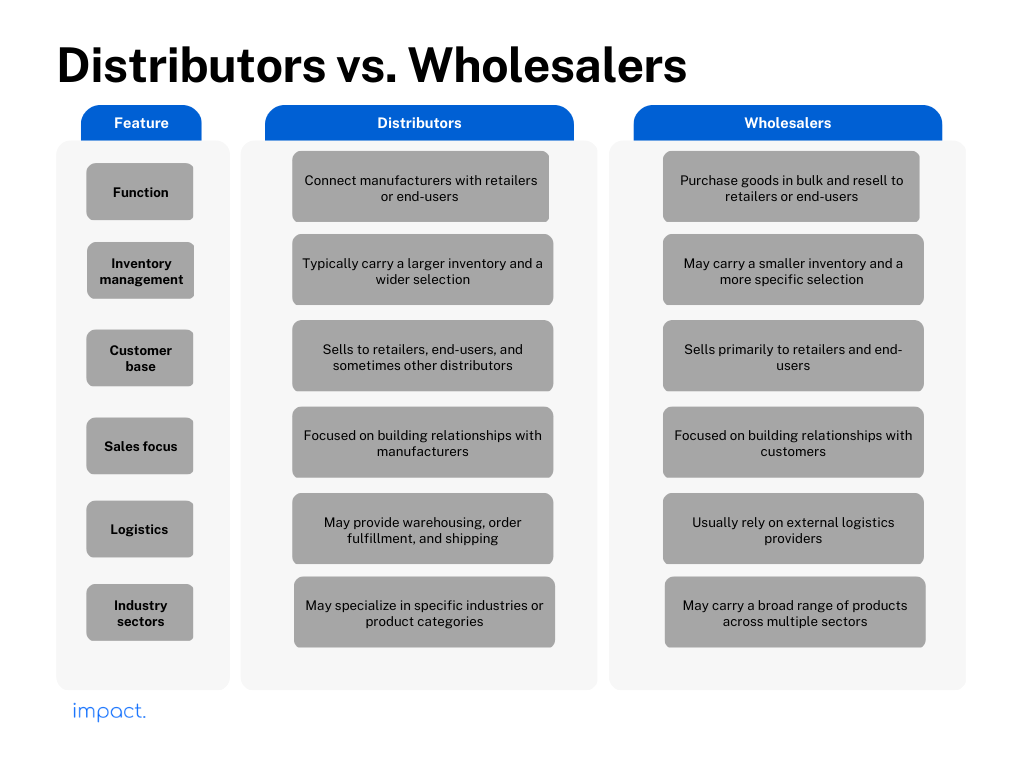
Read More: What is a Wholesaler? Definition, Benefits, and 4 Challenges
Depending on their strategy, distribution can be simple or complicated. Sometimes companies use several distribution channels or techniques. Here are five different types of distributors in the supply chain:
This type of distributor is sometimes called a one-level channel. They provide a simple way to get products to customers without using intermediaries. Manufacturers are an example of direct distributors because they give out their products themselves.
Direct distributors sell their products in different ways, such as online shops, physical stores, door-to-door sales, or directly from the factory. This type of distribution is helpful for businesses because it helps customers trust the brand and improves their experience. Direct distribution is widespread in industries such as cars, technology, and agriculture.
Indirect distributors involve other people or businesses that buy products from manufacturers and sell them to consumers. These distributors could be wholesalers, brokers, or agents.
Sometimes manufacturers don’t have the resources to distribute their products, so they use indirect distribution. This type of distribution also helps businesses reach more customers and make more sales because their intermediaries might have established connections with buyers and customers.
But there are also some downsides to indirect distribution. It adds extra costs, meaning customers pay more for the products. It also slows down the delivery of the products and gives less control to the manufacturer.
This type of distributor gets the exclusive right to sell certain products in a specific area for a set amount of time. Distributors that get this exclusivity are the only ones allowed to sell those products in that area during that time.
The manufacturer and the exclusive distributor make an agreement that outlines everything they need to do, such as pricing, marketing, and sales targets.
For example, a luxury bag manufacturer might only allow a few stores in certain areas to sell their bags through an exclusive distributor. This limited availability gives the distributor much control over how they sell and distribute the bags.
In an intensive distribution model, the distributor distributes products to as many places as possible, unlike an exclusive distributor.
Manufacturers usually use this strategy for products in high demand but sold at a low price, like snacks, drinks, and other fast-moving consumer goods (FMCG).
Businesses use intensive distributors to make their products more visible and accessible to customers. Companies can convert leads to more sales and a more significant market share for the manufacturer.
The role of distributors is critical in the supply chain, as they perform various functions vital to the success of manufacturers and suppliers. Here are the five essential functions of distributors.
Distributors play an essential role in managing inventory levels and stock levels. The function of a distributor is to keep an eye on how much stock they have and ensure they have enough of the right products to meet customer needs.
To guarantee on-time delivery of products to the correct location, distributors need to maintain proper inventory and stock levels. For example, if a retailer requires a specific product, the distributor must have sufficient stock to fulfill the order. Inadequate inventory can delay the delivery of the product to the retailer, leading to dissatisfied customers and missed sales opportunities.
Read more: Just in Time (JIT) adalah: Definisi & 8 Cara Penerapannya
Distributors provide warehousing and storage facilities to store products that they receive from manufacturers. The distributors design these facilities to keep the products safe, secure, and in good condition until they are ready to ship them to retailers or end customers.
While the products are in the warehouse, the distributor is responsible for any possible losses. For example, products may get damaged, expire, or become outdated. It is crucial for distributors to properly handle and dispose of any goods that have expired or are damaged.
Read More: Apa itu gudang? 12 Alasan Mengapa Gudang Dibutuhkan
One function of a distributor is to receive orders from retailers and consumers, process them quickly, and ensure timely delivery. Distributors checks if the products ordered are available and look for additional instructions. Next, the distributor packs the products, generates shipping labels, and schedules the delivery.
Distributors may combine orders from different retailers and consumers into one shipment to save money on transportation costs, called order consolidation. This method is cost-effective as it reduces the number of trips required.
Another function of distributors is the transporting and delivery of goods. Distributors transport products from their warehouses to the buyers who have purchased them. This means that distributors must figure out how to move the products from their warehouse to the buyer’s location.
When a buyer orders products, the distributor makes sure the products are packaged and labeled correctly for shipping. They may hire a shipping company or use their delivery trucks to transport the products.
The distributor is responsible for ensuring that the products are delivered to the buyer safely and in good condition. This involves tracking the products during transit, monitoring temperature and humidity levels, and preventing damage during loading and unloading.
Not many people know that promoting and selling products is an essential aspect of the role of distributors in the supply chain. Distributors must possess market expertise and knowledge of customer needs, which helps them develop customized marketing strategies and sales programs.
Distributors collaborate with manufacturers to create marketing materials and incentivize retailers to sell more products. They use their market expertise to identify new opportunities and work with online and specialty stores to expand sales channels. Additionally, they support retailers by providing product information, training, and merchandising.
Distributors make sure customers are satisfied by handling their questions and complaints. They act as the go-between for the manufacturer and the customer to resolve possible problems.
Distributors assist customers with product issues by coordinating with the manufacturer for a refund or replacement in case of damages. Additionally, they inform customers about product features and warranties. Customer support is crucial for building customer loyalty and trust, benefiting the manufacturer and retailer.
Distributors play a critical role in the supply chain as they provide a range of benefits to both manufacturers and retailers. However, they also have their disadvantages. The table below shows the pros and cons of utilizing distributors.
| Category | Pros | Cons |
| Market Reach | Distributors can help reach a wider market through their established network and relationships with retailers and customers. | Distributors may not prioritize your brand if it is not one of their top performers, and they may not always have the same passion for a business’s product. |
| Logistics | Distributors can take care of the logistical tasks, such as warehousing, shipping, and delivery, allowing you to focus on other business areas. | Businesses may have less control over the shipping and delivery process, and additional costs may be associated with using a distributor. |
| Sales | Distributors can provide sales support and help increase your product’s visibility in the market. | The distributor’s sales force may not always have the same level of knowledge or enthusiasm for your product as you do, and they may not be able to provide the same level of personalized attention to customers. |
| Cost | Distributors can help to reduce costs by allowing businesses to share expenses with other brands, such as warehousing and shipping costs. | Distributors may charge a commission or other fees that can eat into your profits. |
| Risk | Distributors can help reduce risk by assuming responsibility for inventory and sales. |
Companies may have less control over their product’s branding and marketing when using a distributor, and there is always the risk of the distributor going out of business or not performing as expected. |
A distributor’s role can be crucial in determining the success of a business. Whether a company is a newly-established startup or an established corporation does not matter.
Businesses must identify a partner who comprehends their business and has the expertise to assist them in achieving success.
Here are some factors to consider when choosing a distributor:
Customer service: When selecting a distributor, it is crucial to consider their customer service. This refers to the level of support they will provide customers, including handling any issues or complaints they may have promptly and professionally. Good customer service can help build and maintain a positive reputation for businesses. In contrast, poor customer service can lead to negative reviews, lost sales, and damage to brand reputation.
Below are examples of Indonesian and global distributors, categorized based on their areas of specialization.
Distributors from the F&B sector include PT Infofood Sukses Makmur Tbk, PT Mayora Indah Tbk, The Coca-Cola Company, Dole plc, and General Mills.
Distributors from the retail sector include Unilever plc, PT Sinergi Inti Plastindo Tbk, PT Erajaya Swasembada Tbk, PT Mitra Adiperkasa Tbk, and PT Mustika Ratu Tbk.
Distributors from the healthcare sector include PT Kimia Farma Trading & Distribution, McKesson Corporation, Cardinal Health, Alfresa Holdings, and AmerisourceBergen Corp.
Distributors in this sector include PT Pertamina (Persero), PT Perusahaan Gas Negara Tbk, Shell plc, Weatherford International, and Schlumberger Limited.
As the demand for quick delivery continues to rise, the role of distributors becomes more crucial in the supply chain by linking manufacturers and customers.
This article has effectively highlighted distributors’ indispensable role in business by providing readers with a comprehensive overview of their functions, benefits, and different types.
Businesses must consider various factors when selecting a distributor to make informed decisions about their distribution channels. In summary, companies rely heavily on distributors for their success, and one cannot overemphasize their significance.
Impact Insight Team
Impact Insights Team is a group of professionals comprising individuals with expertise and experience in various aspects of business. Together, we are committed to providing in-depth insights and valuable understanding on a variety of business-related topics & industry trends to help companies achieve their goals.
See how our software provides better value.
Speak with our consultant to explore how we can improve your accounting, processes, and people.
